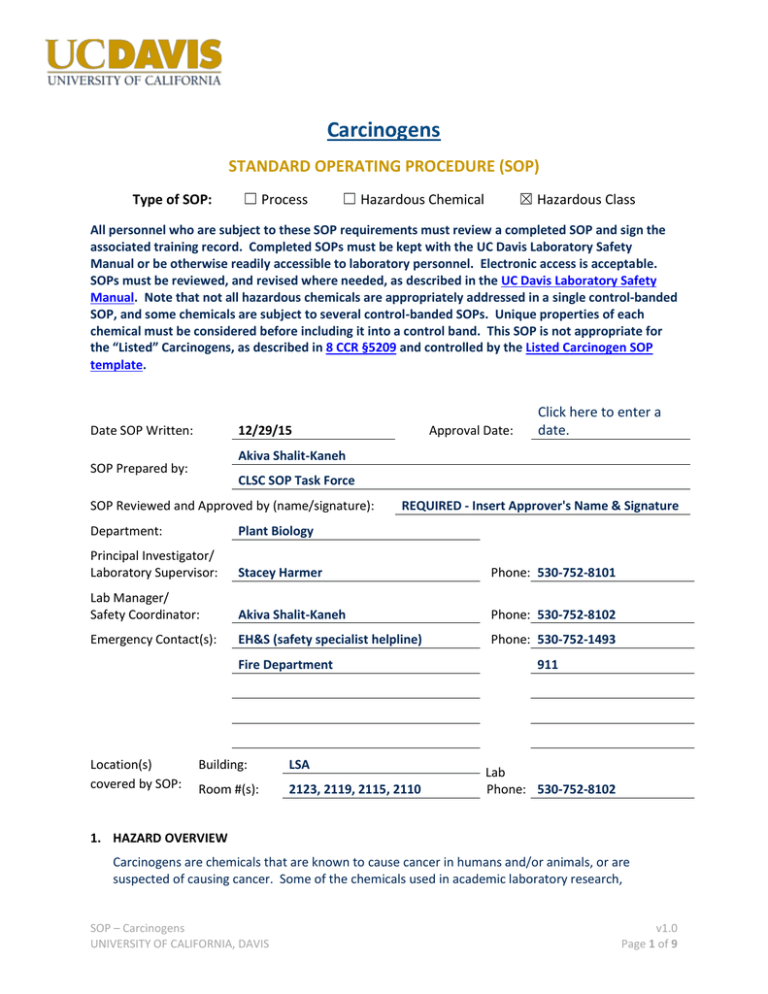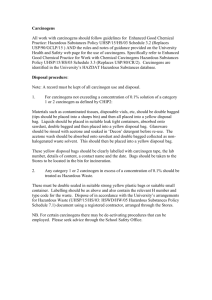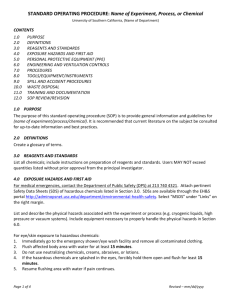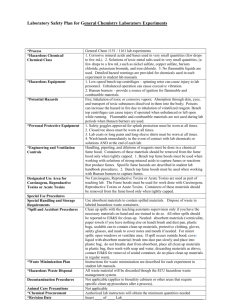Harmer Lab Carcinogen SOPs
advertisement

Carcinogens STANDARD OPERATING PROCEDURE (SOP) Type of SOP: ☐ Process ☐ Hazardous Chemical ☒ Hazardous Class All personnel who are subject to these SOP requirements must review a completed SOP and sign the associated training record. Completed SOPs must be kept with the UC Davis Laboratory Safety Manual or be otherwise readily accessible to laboratory personnel. Electronic access is acceptable. SOPs must be reviewed, and revised where needed, as described in the UC Davis Laboratory Safety Manual. Note that not all hazardous chemicals are appropriately addressed in a single control-banded SOP, and some chemicals are subject to several control-banded SOPs. Unique properties of each chemical must be considered before including it into a control band. This SOP is not appropriate for the “Listed” Carcinogens, as described in 8 CCR §5209 and controlled by the Listed Carcinogen SOP template. Date SOP Written: 12/29/15 Approval Date: Click here to enter a date. Akiva Shalit-Kaneh SOP Prepared by: CLSC SOP Task Force SOP Reviewed and Approved by (name/signature): REQUIRED - Insert Approver's Name & Signature Department: Plant Biology Principal Investigator/ Laboratory Supervisor: Stacey Harmer Phone: 530-752-8101 Lab Manager/ Safety Coordinator: Akiva Shalit-Kaneh Phone: 530-752-8102 Emergency Contact(s): EH&S (safety specialist helpline) Phone: 530-752-1493 Fire Department Location(s) covered by SOP: Building: LSA Room #(s): 2123, 2119, 2115, 2110 911 Lab Phone: 530-752-8102 1. HAZARD OVERVIEW Carcinogens are chemicals that are known to cause cancer in humans and/or animals, or are suspected of causing cancer. Some of the chemicals used in academic laboratory research, SOP – Carcinogens UNIVERSITY OF CALIFORNIA, DAVIS v1.0 Page 1 of 9 industrial processes, and daily activities are carcinogenic. Recognition of the hazards associated with the transportation, use, storage, and disposal of these materials is essential. Precautions must be taken to minimize any potential chemical exposure to Carcinogens. 2. HAZARDOUS CHEMICAL(S)/CLASS OF HAZARDOUS CHEMICAL(S) Carcinogens are chemicals that are capable of causing cancer or tumor development, typically after repeated or chronic exposure. Their effects may only become evident after a long latency period and may cause no immediate harmful effects. Carcinogens regulated by the California Occupational Safety and Health Administration (Cal/OSHA) can be found in Title 8 of California Code of Regulations (8 CCR), Article 110, §5200-5220. Additionally, Cal/OSHA defines Carcinogens in 8 CCR §5191 as materials that meet any of the following: 1. Is a regulated Cal/OSHA carcinogen; 2. Is listed as “known to be carcinogens” in the National Toxicology Program (NTP) Annual Report on Carcinogens; 3. Is listed as Group 1 (“carcinogenic to humans”) by the International Agency for Research on Cancer (IARC) Monographs; or 4. Is listed in either Group 2A (“probably carcinogenic to humans”) or 2B (“possibly carcinogenic to humans”) by IARC or under the category, “reasonably anticipated to be carcinogens” by NTP, and causes statistically significant tumor incidence in experimental animals under defined conditions (see 8 CCR §5191 for more details). Carcinogens can be identified in the Globally Harmonized System by the Hazard Codes H350 (May cause cancer) and H351 (Suspected of causing cancer). Some common examples of UC Davis laboratory Carcinogens include: 1. 2. 3. 4. 5. 6. 7. 8. 9. 10. Arsenic and Arsenic compounds (inorganic) Benzene Cadmium and Cadmium compounds Chromium (VI) compounds Cobalt and Cobalt compounds Dichloromethane Formaldehyde Lead and Lead compounds (inorganic) Nickel compounds Polycyclic Aromatic Hydrocarbons (PAHs) Note, many carcinogens have additional chemical hazards. Review a current Safety Data Sheet for each carcinogen prior to use. Carcinogens in the Harmer lab include Formaldehyde, Imidazole, cyclohexamide and Acrylamide 40%, Chloramphenicol, beta-estradiol, 3-1,1-dimethylurea Formaldehyde - Hazardous in case of eye contact (irritant), of ingestion. Slightly hazardous in case of skin contact (irritant, sensitizer, permeator). Mutagenic for mammalian somatic cells. Classified possible teratogen for humans. The substance may be toxic to kidneys, liver, central nervous system (CNS). Cycloheximide - is a toxic chemical that can be fatal if ingested and harmful if inhaled or absorbed through the skin. It causes irritation to the respiratory tract, skin, and eyes. It may cause damage to SOP – Carcinogens UNIVERSITY OF CALIFORNIA, DAVIS v1.0 Page 2 of 9 fertility and the unborn child. It may also cause genetic defects. Cycloheximide is produced from the bacterium, Streptomyces griseus, and is an inhibitor of protein synthesis by blocking translational elongation. It is mainly used in in vitro research experiments but has been used as a fungicide. Imidazole - Harmful if swallowed. Causes severe skin burns and eye damage. May damage fertility or the unborn child. Acrylamide and bis-acrylamide are both select carcinogens, reproductive hazard and neurotoxins. They are used in polymerized form to analyze the size of proteins and protein-DNA complexes in gel electrophoresis. Acrylamide is purchased as a liquid solution which is highly toxic due to the high potential of absorption through the skin yet this exposure is diminished when acrylamide is in its polymerized form. Acrylamide is also toxic if in contact with skin or swallowed. It is irritating to eyes and skin. It may cause sensitization by inhalation and skin contact and is readily absorbed through skin. The target organs are nerves and kidneys. Chloramphenicol is a CARCINOGEN and is moderately toxic after an acute exposure. Chloramphenicol exposure can occur through ingestion, inhalation, skin and/or eye contact. Chloramphenicol is an irritant to the eyes and respiratory tract. It is only a minor irritant to skin. Acute exposure of the digestive tract can result in gastrointestinal irritation with nausea, vomiting and diarrhea. It may cause liver damage or hemorrhaging of the digestive tract. Exposure may also cause anemia and other blood abnormalities. 3-1,1-dimethylurea : Suspected of causing cancer, Harmful if swallowed, Very toxic to aquatic life with long lasting effects INHALATION: May cause irritation of nose and throat. EYES: Irritation. SKIN: Moderately irritating to skin. Beta-estardiol : Suspected of causing cancer. May damage fertility or the unborn child. May cause harm to breast-fed children. 3. ENGINEERING/VENTILATION CONTROLS Use available engineering/ventilation controls to keep exposure to Carcinogens as low as possible. The following is a general plan for Carcinogens: A. Use containment devices (e.g., chemical fume hoods, glove boxes, localized exhaust (“snorkel”), etc.) when: i. Using volatile and/or semi-volatile substances; ii. Manipulating substances that may generate aerosols; and iii. Performing laboratory procedures that may result in an uncontrolled release. B. Use high-efficiency particulate air (HEPA) filters, carbon filters, or scrubber systems with containment devices to protect effluent and vacuum lines, pumps, and the environment whenever feasible. C. Ventilated containment should be used to weigh out solid chemicals (e.g., ventilated balance safety enclosure, etc.). Alternatively, the tare method can be used to prevent inhalation of the chemical. While working in a fume hood, the chemical is added to a pre-weighed container. The container is then sealed and can be re-weighed outside of the fume hood. If a chemical needs to be added or removed, this manipulation is carried out in the fume hood. In this manner, all open chemical handling is conducted in the fume hood. If you must use Carcinogens without/outside of engineering or ventilation controls, you must contact the Chemical Hygiene Officer or healthandsafety@ucdavis.edu for an exposure assessment. SOP – Carcinogens UNIVERSITY OF CALIFORNIA, DAVIS v1.0 Page 3 of 9 Formaldehyde use in anatomy, histology and pathology laboratories must be evaluated by EH&S to ensure airborne concentrations of formaldehyde are below the Action Level of 0.5 parts per million by volume. When handling carcinogens in the lab use the chemical fume hood in room 2123. If weighing is necessary use the tare method described above in 3.c. 4. ADMINISTRATIVE CONTROLS The following elements are required: 1. Complete the UC Laboratory Safety Fundamentals (or approved equivalent) training prior to working in the laboratory; 2. Complete laboratory-specific safety orientation and training on laboratory-specific safety equipment, procedures, and techniques to be used, including any applicable laboratory-specific Laboratory Safety Plan(s), prior to receiving unescorted access to the laboratory; 3. Demonstrate competency to perform the procedures to the Principal Investigator (PI), Laboratory Supervisor, laboratory-specific Safety Officer, and/or trainer; 4. Be familiar with the location and content of any applicable Safety Data Sheets (SDSs) for the chemicals to be used (online SDSs can be accessed from UC SDS); 5. Implement good laboratory practices, including good workspace hygiene; 6. Inspect all equipment and experimental setups prior to use; 7. Follow best practices for the movement, handling, and storage of hazardous chemicals (see Chapters 5 and 6 of Prudent Practices in the Laboratory for more detail). An appropriate spill cleanup kit must be located in the laboratory. Chemical and hazardous waste storage must follow an appropriate segregation scheme and include appropriate labeling. Hazardous chemical waste must be properly labelled, stored in closed containers, in secondary containment, and in a designated location; 8. Do not deviate from the instructions described in this SOP without prior discussion and approval from the PI and/or Laboratory Supervisor. 9. Notify the PI and/or Laboratory Supervisor of any accidents, incidents, near-misses, or upset condition (e.g., unexpected rise or drop in temperature, color or phase change, evolution of gas) involving Carcinogens described in this SOP; and 10. Abide by the laboratory-specific working alone SOP, if applicable. For Carcinogens, the following are also required: 11. Adhere to the UC Davis Carcinogen Program described in the Chemical Carcinogen Safety Manual and SafetyNet #32; 12. Work surfaces should be protected (e.g., disposable absorbent bench paper, aluminum foil, etc.) and must be decontaminated after each use; 13. All waste containing Carcinogen materials at greater than 0.001% wt., including preserved tissue samples, must be disposed as hazardous waste; and 14. This SOP is not meant to address 8 CCR §5209 “Listed” Carcinogens. If you are using one of these materials you must develop a separate Listed Carcinogens SOP. REQUIRED - Insert the laboratory-specific restrictions on maximum quanities to be used and stored. Formaldehyde is to be kept in the flammable safe cabinet beneath the chemical fume hood in room 2123. Cyclohexamide and Imidazole are to be kept in a Carcinogen hazard labeled area on the SOP – Carcinogens UNIVERSITY OF CALIFORNIA, DAVIS v1.0 Page 4 of 9 chemcial shelf above the scales in room 2115. Acrylamide is to be kept in the flammable proof refrigerator in room 2110. Beta-estradiol - Keep container tightly closed in a dry and well-ventilated place. 5. PERSONAL PROTECTIVE EQUIPMENT (PPE) At a minimum, long pants (covered legs) and closed toe/closed heel shoes (covered feet) are required to enter a laboratory or technical area where hazardous chemicals are used or stored. In addition to the minimum attire required upon entering a laboratory, the following PPE are required for work with Carcinogens: A. Eye Protection: Eye protection is required for all work with Carcinogens. i. At a minimum ANSI Z87.1-compliant safety glasses are necessary. ii. Splash goggles may be substituted for safety glasses, and are required for processes where splashes are foreseeable or when generating aerosols. iii. Ordinary prescription glasses will NOT provide adequate protection unless they also meet the Z87.1 standard and have compliant side shields. B. Body Protection: At a minimum a chemically-compatible laboratory coat that fully extends to the wrist is necessary. i. If a risk of fire exists, a flame-resistant laboratory coat that is NFPA 2112-compliant should be worn. ii. For chemicals that are corrosive and/or toxic by skin contact/absorption additional protective clothing (e.g., face shield, chemically-resistant apron, disposable sleeves, etc.) are required where splashes or skin contact is foreseeable. C. Hand Protection: Hand protection is needed for the activities described in this SOP. Define the type of glove to be used based on: A) the chemical(s) being used, B) the anticipated chemical contact (e.g., incidental, immersion, etc.), C) the manufacturers’ permeation/compatibility data, and D) whether a combination of different gloves is needed for any specific procedural step or task. When handeling carcinogens use your assigned lab coat (for formaldehyde use flame resistant lab coat), safety glasses and gloves. Work in the Chemical fume hood and clearly label any aliquot you are making as a carcinogen along with any other hazard category the substance falls into.REQUIRED - Insert descriptions of PPE and hygiene practices used with the Carcinogens described in this SOP. Include any specialized PPE needed for a procedural step/task. 6. SPILL AND EMERGENCY PROCEDURES Follow the guidance for chemical spill cleanup from SafetyNet #13 and/or the UC Davis Laboratory Safety Manual, unless specialized cleanup procedures are described below. Emergency procedure instructions for the UC Davis campus and UCD Medical Center are contained in the UC Davis Laboratory Safety Manual and the Emergency Response Guide (which must be posted in the laboratory). All other locations must describe detailed emergency procedure instructions below. For spills of solid materials, DO NOT dry sweep. SOP – Carcinogens UNIVERSITY OF CALIFORNIA, DAVIS v1.0 Page 5 of 9 For spill clean up refer to safetyNet #13, if you do not feel confident with the task ask other lab members for assistance. The Harmer lab spill kit is located in the cabinet beneath the sink to the left of the chemical fume hood. Cyclohaxamide - Wearing proper PPE, decontaminate equipment and bench tops using soap and water. If there is a solid spill cover with wet paper towels to avoid ariborn dust formation. For liquid spills soak with absorbents from spill kit under the sink in room 2123 to the left of the chemical fume hood.or paper towels. Double bag paper towels or absorbing material used for collection label properly and have them collected by EH&S, same for Acrylamide, Formaldehyde, Imidazole. REQUIRED - Insert descriptions of any specialized spill clean up procedures for hazardous chemicals used in this SOP (e.g., hydrofluoric acid, pyrophorics, phenol, etc.). Additional details of lab-specific spill cleanup should be provided if applicable. INSERT IF APPLICABLE - Descriptions of any specialized emergency procedures for locations outside of the UC Davis main campus and the UCD Medical Center campus. EH&S must be notified immediately for any uncontrolled release of Carcinogens; please call (530) 752-1493. Some examples of an uncontrolled release include, but are not limited to, equipment failure, rupture of containers, or failure of control equipment. EH&S must report this information to Cal/OSHA within 24 hours. 7. WASTE MANAGEMENT AND DECONTAMINATION Hazardous waste must be managed according to Safety Net #8 using the appropriate label. In general, hazardous waste must be removed from your laboratory within 9 months of the accumulation start date; refer to the timeline for waste disposal. Hazardous waste pick up requests must be completed online. Cyclohexamide - for liquid waste use liquid waste container in the chemical fume hood room 2123. For solid waste such as tips and tubes use double bagged solid waste bag also in the chemical fume hood, if such a container is not present or if it is full contact the lab's safety officer. Same for Acrylamide, Formaldehyde, Imidazole. REQUIRED - Insert descriptions of laboratory-specific information on the waste streams generated, storage location, and any special handling/storage requirements. Decontamination procedures vary depending on the material being handled. Carefully inspect work areas to make sure no hazardous materials remain. Following dispensing or handling, all surfaces and equipment should be wiped with the appropriate cleaning agent to prevent accumulation of Carcinogen chemical residue. Dispose of cleaning materials properly. Be sure all ignition sources are secured before beginning clean up with flammable liquids. Decontaminate vacuum pumps or other contaminated equipment before removing them from the regulated area or before resuming normal laboratory work in the area. Cyclohaxamide - Wearing proper PPE, decontaminate equipment and bench tops using soap and water, collect the spill with paper towels or absorbant from the spill kit under the sink in room 2123 to the left of the chemical fume hood. Double bag paper towels or absorbing material used for collection label properly and have them collected by EH&S. REQUIRED - Insert descriptions of decontamination procedures for equipment, glassware, and controlled areas (e.g., glove boxes, restricted access hoods, perchloric/hot acid fume hoods, or designated portions of the laboratory). SOP – Carcinogens UNIVERSITY OF CALIFORNIA, DAVIS v1.0 Page 6 of 9 Upon completion of work with Carcinogens and/or decontamination of equipment, remove gloves and/or PPE to wash hands and arms with soap and water. Additionally, upon leaving a designated Carcinogen work area remove all PPE worn and wash hands, forearms, face and neck as needed. Contaminated clothing or PPE should not be worn outside the lab. Soiled lab coats should be sent for professional laundering. Grossly contaminated clothing/PPE and disposable gloves must not be reused. 8. DESIGNATED AREA Designated area(s) for the use and storage of Carcinogens shall be established where limited access, special procedures, knowledge, and work skills are required. Signage indicating the materials being used and/or stored and the applicable hazards should be easily visible for the designated work space and/or storage area, for example: DANGER! CARCINOGEN WORK AREA! Carcinogens are stored in several places in the lab in rooms 2123 and 2115. Areas with carcinogens are labeled with a carcinogen hazard symbol or notice. 9. DETAILED PROTOCOL When using carcinogens use gloves a lab coat and safety glasses. Work with the substance in the chemcial fume hood, if needed aliquote carefuly into a new container and label that container with all the hazard information provided on the original container. If weighing is necessary use the tare method described above in 3.c. Dispose of all waste, liquid or solid in the appropriate waste container located in the chemical fume hood. In case of a spill refer to safety net #13, in case of contamination of glass ware or other equipment clean with paper towels water and soap. Dispose of paper towels in double bags and have them collected by EH&S.REQUIRED - Insert or attach detailed laboratory-specific procedures for the process, hazardous chemical(s), or hazard class. You may also include any relevant supporting resources such as SafetyNets, journal citations, etc. that are applicable. SOP – Carcinogens UNIVERSITY OF CALIFORNIA, DAVIS v1.0 Page 7 of 9 TEMPLATE REVISION HISTORY Version 1.0 Date Approved 4/14/2015 Author CLSC Task Force Revision Notes: New template LAB-SPECIFIC REVISION HISTORY Version Date Approved SOP – Carcinogens UNIVERSITY OF CALIFORNIA, DAVIS Author Revision Notes: v1.0 Page 8 of 9 Documentation of Standard Operating Procedure Training (Signature of all users is required) Prior to using Carcinogens, laboratory personnel must be trained on the hazards described in this SOP, how to protect themselves from these hazards, and emergency procedures. Ready access to this SOP and to a Safety Data Sheet for each hazardous material described in the SOP must be made available. The Principal Investigator (PI), or the Laboratory Supervisor if the activity does not involve a PI, must ensure that their laboratory personnel have attended appropriate laboratory safety training or refresher training within the last three years. Training must be repeated following any revision to the content of this SOP. Training must be documented. This training sheet is provided as one option; other forms of training documentation (including electronic) are acceptable but records must be accessible and immediately available upon request. Designated Trainer: (signature is required) I have read and acknowledge the contents, requirements, and responsibilities outlined in this SOP: Name SOP – Carcinogens UNIVERSITY OF CALIFORNIA, DAVIS Signature Trainer Initials Date v1.0 Page 9 of 9


